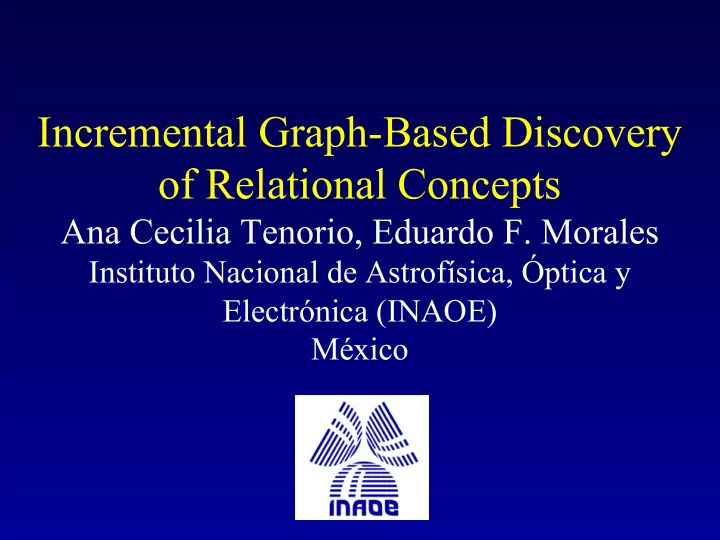

Incremental Graph-Based Discovery of Relational Concepts Ana Cecilia Tenorio, Eduardo F. Morales Instituto Nacional de Astrofísica, Óptica y Electrónica (INAOE) México
Overview • Explore the environment and gather information from sensors • Use BK to identify objects and relations • Repeated information ≈ potential concepts • Incrementally build a graph • Induce a new concept: • Find frequent sub-graphs (Subdue) • Generalize over similar sub-graphs (Progol) • Replace the induced concept in the graph by a new node and repeat
Experimental Setup • Mobile robot with sensors (simulation) • Background knowledge able to recognize from information of sensors: • Objects: vertical surfaces (walls, back of chairs), horizontal surfaces (tables, seats), legs, … • Relations: above, in-front, next-to, …
Incremental Graph Construction
Incremental Graph Construction
Incremental Graph Construction
Incremental Graph Construction
Incremental Graph Construction
Incremental Graph Construction
Incremental Graph Construction
Find common sub-graphs
Find common sub-graphs • Sub-graph isomorphism (NP-complete) • Graph discovery system - Subdue (Holder et al. 94) • Heuristic beam search using MDL • Allows small mismatches - to cope with errors in sensors • Fast: 100 nodes & 100 arcs in ≈ 5 sec, 4K nodes & 4K arcs ≈ 15 sec
Group similar sub-graphs • Each sub-graph represents a potential concept • If a new sub-graph is similar (high proportion of common literals or small cost of structural changes) to existing sub-graphs in a group • Then adds it to the group and generalize • Else create a new group
Induce new concepts • Transform graphs into predicates (E+) • Clause body = relations in sub-graph • Clause head = new predicate symbol with args = distinctive arguments in body • E- = graphs from other groups + artificially created • Use an ILP algorithm (Progol) to learn a new concept
Hierarchical Concepts • Replace new concept by new node in the original graph • May involve instantiations and inexact matching • Repeat the whole process until no more sub-graphs are found • Can induce hierarchical concepts
Simplify
Simplify
Hierarchical Concepts
Experiments • A simulated Pioneer 2 robot with laser (Player/Stage) • BK: wall/1 and touches/2
Experiments • Polygons, BK: line/1, curve/1, angcc/2, angcx/2 • Furniture, BK: flat_board/1, leg/1, …, on/2, next_to/2, behind/2, in_front_of/2, above/2
Experiments
Experiments
Conclusions • Incremental discovery of new concepts • Graph-based, common sub-graphs, ILP • Tested on simulation and artificial domains Future Work • Define an exploration strategy • Incorporate actions to perform tasks • Test on a real robot
Recommend
More recommend